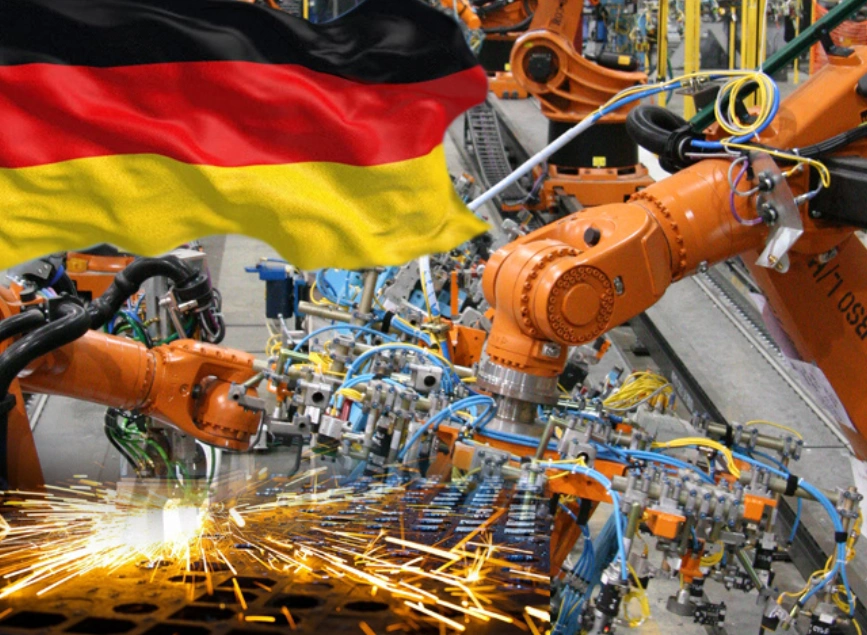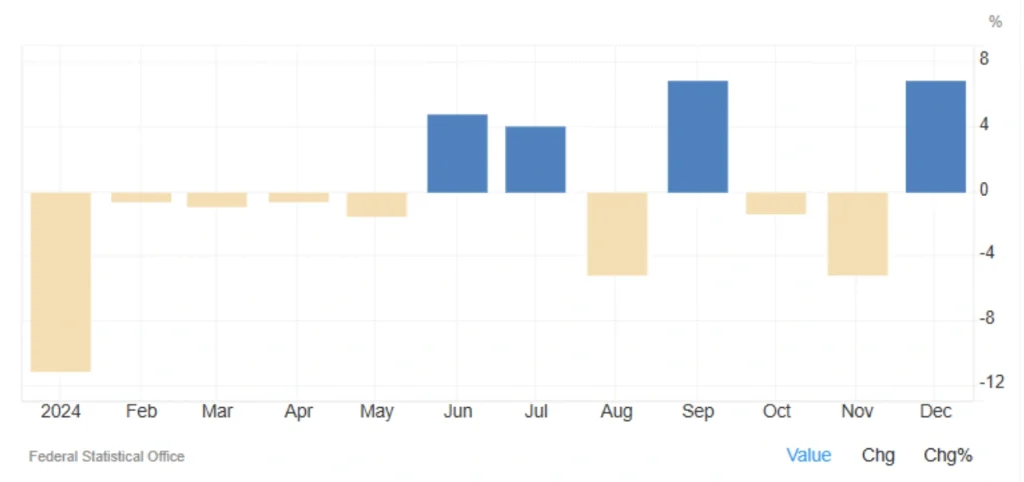
Significant Increase in Factory Orders in Germany: December 2024
Germany’s factory orders surged by 6.9% in December 2024, showing a substantial recovery from November’s 5.2% decline. This growth far exceeded market expectations, which had forecast a 2% increase. This marks Germany’s first growth in factory orders in three months and the highest growth rate since September 2024, suggesting a rebound in industrial activity.
Key Highlights of Germany’s Factory Orders Growth
Significant Growth in Large Orders
- Aircraft, Ship, and Train Orders: These categories saw a remarkable 55.5% rise, significantly contributing to the overall increase.
- Machinery and Equipment Orders: Increased by 8.6%, highlighting strength in industrial demand.
Decline in the Automotive Sector
Despite the overall positive growth, the automotive sector faced a downturn, with demand for cars falling by 3.2%. This reflects ongoing challenges for one of Germany’s most critical industries.
Broad-Based Growth Across Goods Categories
- Capital Goods: Grew by 10.9%, driven by strong industrial demand.
- Consumer Goods: Experienced a 7.7% increase, indicating robust domestic consumption.
- Intermediate Goods: Rose slightly by 0.2%, showing moderate stability in supply chain demand.
Domestic vs. Foreign Orders
- Domestic Orders: There was a notable 14.6% increase in domestic orders, signaling strengthened internal demand.
- Foreign Orders: Growth in foreign orders was limited to 1.4%.
- Orders from the Eurozone increased by 6.2%, providing some positive news for the region.
- Orders from other parts of the world dropped by 1.5%, reflecting challenges in global demand.
Read More: Germany’s Services Sector Returns to Growth
Quarterly and Annual Trends
- Fourth Quarter Comparison: Factory orders remained unchanged in the fourth quarter compared to the previous period, signaling a period of stability following previous declines.
- Annual Comparison: On a yearly basis, adjusted for calendar effects, factory orders decreased by 3%, reflecting an overall decline in 2024 despite the December boost.
Will Germany’s Industrial Orders Improvement Be Sustainable?
While the 6.9% increase in December is encouraging, there are some factors that may limit the sustainability of this growth:
- Reliance on Large Orders: The heavy contribution of large orders (aircraft, ships, etc.) may not be consistent, as such large contracts can be irregular.
- Automotive Sector Challenges: The decline in demand for cars could put a dampener on future growth, especially since the automotive industry is a key pillar of Germany’s economy.
- Weak Global Demand: The decrease in orders from outside the Eurozone could pose challenges for export growth, which is vital for Germany’s industrial sector.

Educational Section: Why Are Factory Orders Important?
What Is the Factory Orders Index?
The factory orders index measures the level of new demand for manufactured goods in a country. It’s a crucial indicator that provides insights into industrial and economic growth trends, helping policymakers, investors, and economists understand the health of the manufacturing sector.
How Do Factory Orders Affect the Economy?
Factory orders have a direct impact on economic growth:
- Growth in Orders: Generally leads to increased production, employment, and investment, stimulating overall economic activity.
- Decline in Orders: May signal reduced demand or a potential recession, as businesses pull back on production and investment.
This index is used by investors and central banks to gauge economic conditions and make decisions regarding monetary policy.
Why Are Germany’s Factory Orders Important?
As Europe’s largest industrial economy, Germany’s factory orders are closely watched. Changes in German orders have far-reaching effects on:
- The Eurozone Economy: Germany’s performance is a key driver of regional growth.
- Global Markets: As one of the largest exporters, shifts in Germany’s industrial production influence global supply chains.
- European Central Bank (ECB) Policy: A significant change in orders could impact ECB’s decisions on interest rates and monetary stimulus.
Conclusion: Is Germany’s Industrial Production on the Path to Recovery?
The 6.9% increase in factory orders in December 2024 is a positive development for Germany’s industrial sector, indicating signs of recovery. However, the heavy reliance on large orders and the ongoing challenges in the automotive sector and global markets suggest that sustaining this growth may be difficult. Traders, investors, and policymakers will need to carefully monitor these trends in the months ahead to assess whether the recovery can be maintained.
Share
Hot topics

Federal Reserve’s Challenges to Trump’s New Policies
As the Federal Reserve Open Market Committee (FOMC) prepares for its upcoming meeting, all eyes are on how the Fed will respond to Donald Trump’s latest economic policies. With the...
Read more




Submit comment
Your email address will not be published. Required fields are marked *